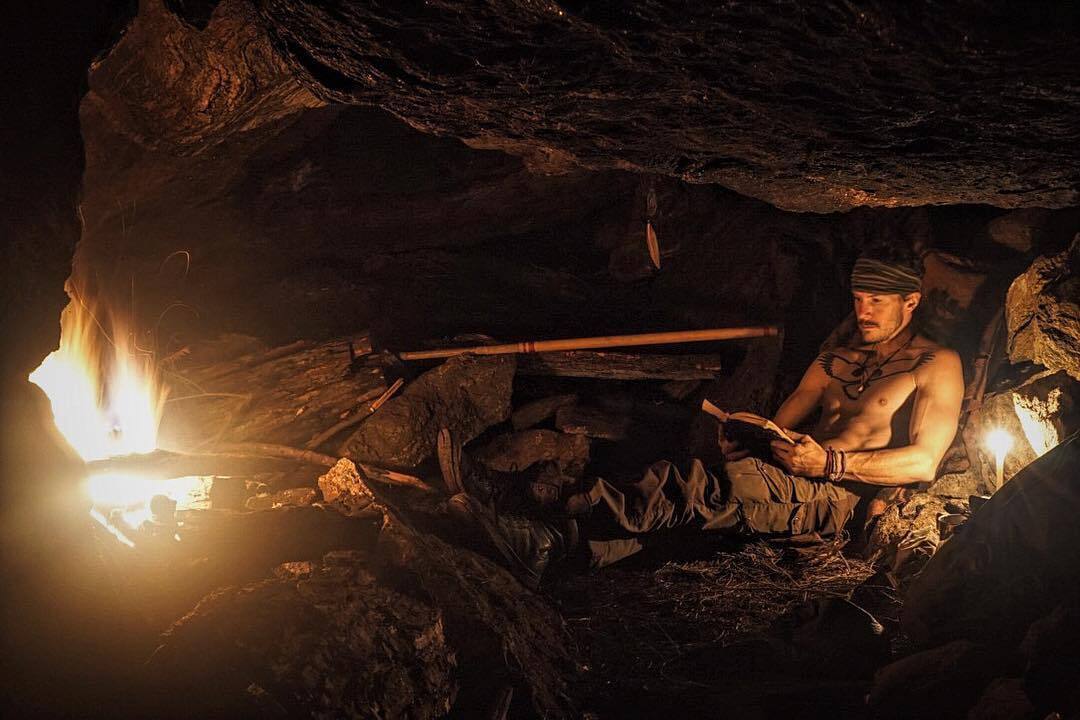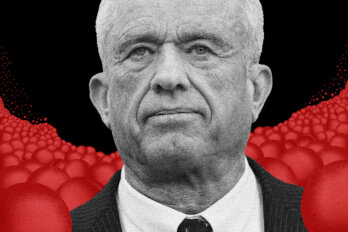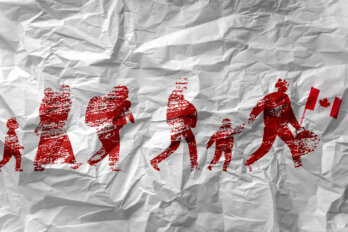Listen to an audio version of this story
For more audio from The Walrus, subscribe to AMI-audio podcasts on iTunes.
After three weeks, Justin Alexander Shetler emerged from a cave deep in the Indian Himalayas with a heightened determination to take a greater step on his journey. The restless American traveller, trained in wilderness survival, gathered his few belongings, stuffed them into his day pack, and descended along the forest trail, returning to the village of Kalga in the Parvati Valley. He had a new goal and he needed to prepare.
On August 13, 2016, after three weeks of inactivity online, his social media accounts, Adventures of Justin, blinked back to life with new posts and photos for his horde of followers. (Since 2006, he rejected his surname and preferred going by Justin Alexander instead.) “I’ve been living in some caves in the Indian Himalayas for the last couple weeks,” Justin wrote, under a self-portrait he had taken while reclining inside his cave, together with a series of hashtags including #caveman, #nomadiclife, and #freedom. He outlined his new plan: “I just came down from the mountain and will soon head back. A Sadhu has invited me on a pilgrimage high in the Himalayas to meditate . . . . He invited me along on his pilgrimage: three days hard trek to a lake at 13,000ft (4000m), and then ten days meditating in spiritual retreat, living amongst the rocks, in a place without vegetation or wood to burn. Then three days back to a small village.” On Instagram he wrote that his next journey “might be the hardest thing I’ve ever done.”
He also posted a picture of the sadhu—a Hindu holy man—he had befriended, a black-and-white photograph of Satnarayan Rawat sitting cross-legged in his stone hut and drawing on a chillum. Tendrils of smoke snake from the end of his clay pipe. Behind him, the faces of three Hindu gods look down from posters affixed to the wall of his hut. Large swellings on Rawat’s wrists and elbows are in full view. Sadhus, Hindu ascetics who have renounced their possessions, wander a path toward spiritual fulfillment in the form of moksha, freedom from the endless cycle of reincarnation. They are often called by the honorific baba, meaning “father.”
A long post introducing Rawat to Justin’s followers accompanied the photo. Justin wrote that the sadhu had told him he had cut off his penis as an extreme renunciation of lust; Justin mentioned that he found the act “both upsetting and impressively dedicated.” Rawat asked Justin if he liked women. When Justin answered affirmatively, the sadhu shook his head: “Nai baba!” he told him. “I am not a baba he says. Confirming that I’m unwilling to truly renounce the world,” Justin quipped. Many sadhus (sadhvis if female) practise tapas, expressions of austerity or devotion, from meditation to much more extreme tests of exertion, self-flagellation, or fatigue. One man sat in the same spot for twenty-two years; another remained standing for seventeen years.

After picking up his motorcycle by the half-built hydroelectric dam near Kalga, Justin rode down the bumpy road to purchase supplies for the trek to Mantalai Lake, passing buses of tourists and pilgrims heading up the valley, until the steam from the hot springs at Manikaran and the prayer flag–draped bridges that cross the Parvati River came into view. The Parvati Valley, home to sacred sites for Hindus and Sikhs, is popular with pilgrims and trekkers and is famous for its holy hot springs and rugged landscape. But it also holds a dark history: over the past few decades, dozens of international tourists have mysteriously vanished in and around the valley, earning this tiny sliver of the subcontinent a reputation as India’s backpacker Bermuda Triangle.
When he reached Kasol, Justin wandered the town’s market streets, purchasing food and a blue tarpaulin for a trek along a route Andrey Gapon, a Russian traveller and recent acquaintance of Justin’s, was at the time navigating. After Gapon completed his trek, he felt pulled to return to the Parvati Valley. When he found cell service again, he saw Justin’s posts about Rawat the sadhu and the plan to trek to the lake. In the midafternoon of August 21, he met up with Justin at the Om Shanti guesthouse along with Christofer-Lee Humphreys, a fellow traveller from France, and Villas Bambroo. Bambroo recognized Justin as the man he’d previously seen sitting on the grassy hill at Kheerganga, playing a flute. Bambroo, who was originally from Kashmir but was living in the central Indian city of Indore, had visited the Parvati Valley many times before, but this year he had arrived with a plan to make a pilgrimage to the holy lake.
Justin listened attentively as Gapon and Bambroo recounted their separate treks. “Mantalai Lake is a very special place,” Gapon told him. “It has energy that is transforming. It makes karma work very fast.” But Justin leaned in when Bambroo told his story—of how, two weeks earlier, he had completed the journey entirely solo. He had carried little food, he told the group sitting on red plastic chairs in Om Shanti’s courtyard, just some paneer (a kind of fresh cheese) and a bag of potatoes that he had preboiled—food that would be easy to prepare in the absence of firewood. He had also packed nothing in terms of shelter, as he had heard that there were boulder caves along the route and that a blanket would suffice. Despite the muddy trail, he moved quickly, reaching his destination within three days. He settled into a shelter built of stones in the lee of a boulder near the lakeshore. For two days, nobody else arrived. Then, over the next few days, a group of trekkers or a solitary pilgrim would approach the holy lake in the evening, camp for the night, and depart in the morning. During the nights, he kept warm by making a small fire out of wood shavings he had collected among the rocks and some trekkers’ discarded kerosene.
Bambroo had spent eight nights at the lake, relishing the quiet and the solitude. As time passed, he told Justin, he had experienced a transformation: he came to feel total fear in the light of day and complete comfort and calm in the dead of night until, he says, his existence became clearer. “When you are up in the mountains,” he says, “this idea of one mind and individual selves and bodies leaves you, and you become connected to a bigger self, which is the nature, which is the mountains, which is the flowing river, which is something more than you.” In this state, it is easier to approach a greater force, whether it goes by the name of God or Shiva or the universe or nature, whether it appears externally or arises within. You are forced to reconcile how you relate to the mountain or the river, the glacier or the star. “It’s also asking you if you want to stop here or move, and if you’re keen on going ahead to see what’s in store for you—your way forward.” Each day, Bambroo confronted those forces, those questions. After his food ran out, on the ninth day, he packed his blanket and made his way back down the trail to Kalga.
Justin asked him to outline the main stages of the route, how far someone could walk in a day, and the approximate location of the boulder cave shelters. Bambroo said there were a few located around Pandu Pul, Thakur Kuan, and Mantalai Lake, but he also mentioned that there was another cave off the main trail, much larger than any along the route. Justin then asked Bambroo to take a look at his provisions in his guesthouse room. Most of Justin’s belongings were packed in a large green backpack, except for the few items he was planning on taking to Mantalai Lake. Bambroo examined the food Justin had bought and figured that it was enough but not a lot, especially since Justin said he was planning a journey of around a month. It was then Justin revealed that he was in fact going on the trek not alone but with a sadhu he hoped could teach him his ways. Bambroo remembers feeling concern. “I haven’t met any holy man who could really teach me, who would be different from a schoolteacher,” he says. “It’s not that they’re fake, but they’re not as learned or as holy as they claim. They are also travellers, and in order to get by and in order to live their journey, they have to hold to this image of a baba that serves their purpose.”
Gapon and Humphreys had both briefly interacted with Rawat in Kheerganga and had found the experience uncomfortable. Gapon had seen the sadhu demand money and hash from those who sat before him in exchange for a blessing. Humphreys, who had spent weeks in Kheerganga during the Rainbow Festival earlier that summer, had always been wary of Rawat, who had been banned from some cafés in Kheerganga because he was known to pick tourists’ pockets. “Some babas are very charming and outgoing, but this baba was rough and crude,” he says, noting that “there was something that was very hard and very aggressive with his spirit.” Humphreys warned Justin to be cautious with the sadhu, but the American seemed to shrug off his concerns.
For centuries, India has enthralled Westerners looking for an exotic getaway, a brief immersion in yoga and meditation, or in rare cases, a true pilgrimage to find spiritual revelation. Bambroo had seen other foreigners succumb to the pressure to experience profound moments of realization during their Indian travels. In his estimation, Justin’s motivation was flawed, as he was embarking on the journey to prove something rather than to find peace. And, as competent as he appeared in the outdoors, he didn’t know the terrain. “When I met Justin,” Bambroo says, “I felt that his journey was more of a challenge. And, when you challenge the mighty mountains, especially the Himalayas, which have their own spirit and their own energy that resonates, however you challenge them, they give you your own challenge. And sometimes you don’t get through.”
As Justin detailed his plan, Bambroo remained mostly quiet. Justin picked up on the Indian man’s unease, clarifying that he wasn’t planning on spending the whole time at the lake with the sadhu. His idea was to have the man guide him along the trail, spend a few days together at the lake, and then tell the sadhu to leave and return to Kheerganga. Justin hoped to remain at Mantalai Lake alone, as Bambroo had done.
As the sun sank lower toward the hills, the four men left the guesthouse and weaved through the buildings and apple trees and up the hill overlooking the village. They wanted to find a view of the sunset and of the whole valley before them. Perched on a large boulder, the group watched the sun dip toward the mountains. It set directly over the mouth of the valley, casting a vibrant orange glow, one last flare of light and colour before the sky went dark.
Before Justin departed, while he still had cell service, he made a series of phone calls to people he cared deeply about: friends, at least two former girlfriends, and family back home in the United States. Linda Borini, a former girlfriend and frequent travel companion, remembers seeing his pixelated face appear on her phone and noticing how gaunt it was. “That’s when I got worried,” she recalls. “He was so skinny, he was so frail.” She remembered that they had both lost some weight during their hike in Nepal, in May, but his new state was alarming. Still, she trusted him to know the limitations of his body.
Justin told her that, because of doing this trek, he wouldn’t have enough time to ride his motorcycle to Ladakh, the journey they had both dreamed of one day completing, as the nearly four-kilometre Rohtang La mountain pass would be impassable with snow by the time he returned. She told him that many people ride motorcycles along that renowned highway but that this journey, a pilgrimage to a remote holy lake in the company of a sadhu, was an opportunity for a unique experience that the vast majority of people who travelled to India would never be fortunate enough to have. “You owe it to all the people who want to have this kind of adventure but can’t,” she said to him, words that have weighed heavily on her ever since. Justin said that he was falling in love with India and that, even though he was only a third of the way though his six-month tourist visa, he felt he needed more time in the country. He told her that he had met someone in India who could help him extend his visa by another six months and lamented that his visa wasn’t the kind that lasted ten years. Borini asked when he planned on returning to the United States. Justin was frank: “I don’t think I’m going to come back.”
Justin called his mother and walked her through his plan. Every time her son mentioned the word sadhu, Suzie had a “visceral reaction” that she couldn’t explain. She never wanted to project anxiety onto her son, but she couldn’t hold back from telling him that she was worried about this journey. “If you get up there and it’s not right, what can you do?” she asked him. He told her that he felt compelled to go but reassured her, as he had done many times before, that everything would be fine.
Then he called his father. In the two years prior, they had largely reconciled and reconnected, but Justin had seen Terry only once: he had arranged a stopover in Florida while flying back to California after attending a survival class in the Caribbean. So, when Terry picked up the phone and listened to his son describe a plan to embark on a possibly month-long hike to Mantalai Lake with a sadhu, he didn’t feel in a position to offer cautionary fatherly advice. As he had told his son when he was a boy, he wanted to support him in his search for contentment. Still, Terry couldn’t help but flash back to his own trip to India, in the late 1970s, and warnings the tour group had received about sadhus.
But he didn’t want to dissuade him. In the moment, he felt that Justin was about to find what he was looking for, as Terry had on his own journey in India. “I couldn’t ask him not to do it. The light is hard to refuse.”
On the morning of August 22, Justin packed his day pack with some rice, oats, nuts, raisins, tea, sugar, and flour to make chapatis—very little for someone hoping to subsist for nearly a month of trekking in the Himalayas. Rawat had told him that “he doesn’t need to eat,” Justin had written. He carried no tent or stove, just a thin sleeping bag, his metal cup, and his machete. He packed a large tan wool shawl that he could wrap around his shoulders or use as a blanket, and he wore his khaki hiking pants, a white long-sleeved Tibetan-style shirt that buttoned at the side, and a black lightweight down jacket. He also brought dental floss, less for oral hygiene than for its manifold backcountry uses: as rope or thread, clothesline or makeshift shoelace, fishing line or snare. There was confidence in what little he packed as well as what he left behind. Still, something was weighing on him. “He had a feeling that something was going to go down up there, a premonition or something,” recalls Humphreys, who saw Justin off at the Om Shanti guesthouse. Before Justin left, he joked to Humphreys, “If I die, write something nice about me on Facebook.”
Humphreys shot him a look. “Don’t talk like that,” he told him. “Come back down safe.”
Justin’s heart was in the journey to Mantalai Lake, but he worried that his body would hold him back. “I’ve been cold, damp, and hungry a lot recently, and feeling a bit malnourished and weak already. I think this is going to be a challenge on every level and I’m nervous,” he wrote as a conclusion to the final post he uploaded to his blog. He noted that the area around Mantalai Lake was completely “uninhabited” and that the trail was “notorious and it’s landslide season.” He expressed concern that because he and Rawat didn’t share a common language, communicating any “ancient doctrine” would be a challenge.
“But from what I understand,” Justin continued,
My back is in bad shape, (broken when I was 19) and even with daily soaks in hot springs, this cave/mountain life has recently put me in a state of constant discomfort. I’m sadly inflexible, and I can’t even sit still for a few minutes without pain.
Maybe Baba Life will be good for me. I should return mid September or so.
If I’m not back by then, don’t look for me ;)
Excerpted from Lost in the Valley of Death: A Story of Obsession and Danger in the Himalayas by Harley Rustad. Copyright ©2022 Harley Rustad. Published by Knopf Canada, a division of Penguin Random House Canada Limited. Reproduced by arrangement with the publisher. All rights reserved.



